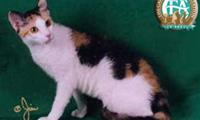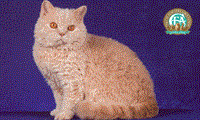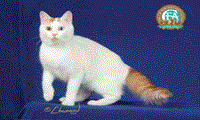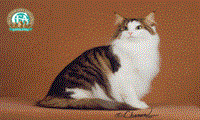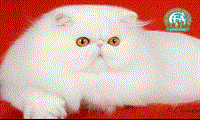
CFA官方關於伯曼貓品種簡介的中文翻譯版本以及英文原版內容。
品種:
有四個變種:海豹色重點色伯曼貓(帶深褐色重點色的淡乳黃色貓)、藍色重點色伯曼貓(帶藍灰色重點色的淺藍-白色貓)、朱古力重點色伯曼貓、淺紫重點色伯曼貓。 在美國尚有一種變種, 短毛、四蹄踏雪, 亦稱“雪鞋貓”或“銀邊貓”, 不過尚未得到公認。
原產地:緬甸
習性:
伯曼貓溫文爾雅, 非常友善, 叫聲悅耳。 溫順友好, 渴求主人的寵愛, 喜歡與主人玩耍, 對其他貓也十分友好。 它們一旦在新的環境中感到安全, 便會流露其甜美及善良的性格。 它們喜歡在地上活動, 但並不熱衷於跳躍及攀爬, 亦喜愛玩耍, 但從不對其飼主有所要求。 愛乾淨, 在舒適的家中生活很愉快, 天氣晴朗時也喜歡到庭院或花園裡散步。
繁殖方式:胎生
體部描述:
頭部:頭前部向後方傾斜, 稍呈凸狀。 面頰肌肉發達, 呈圓形。 臉面毛短, 但頰外側毛長, 鬍鬚密。
耳朵:中等長度。 耳朵大而向前豎立, 耳端稍渾圓, 兩耳尖間距寬, 兩耳根部間距適中, 面頰和耳朵都呈現頗具特徵的“V”字形, 與頭部輪廊十分協調。
眼睛:又圓又大, 看起來好像會說話般, 而且間距較寬。 眼睛的顏色呈清澈的藍色, 深藍比淺藍較為理想。
鼻子:鼻樑又高又直, 中等長度, 鼻尖稍緩慢下降, 略呈鷹鉤鼻狀。
四肢:四肢粗短, 骨胳發達, 肌肉結實、有力;前肢直立。
足掌:趾大而圓, 握力大, 爪短有力, 爪白色, 像戴了白手套般。 前趾的部分稱為“手套”, 後趾的部分叫做“蕾絲”(Laces), 並伸至關節點。
尾巴:尾長中等, 與身體協調,
披毛:長毛但較波斯貓稍短, 不會糾結, 容易梳理, 毛長而厚密, 毛質如絲, 細密而富有光澤;頸部飾毛長, 但肩胛部被毛短;胸部至下腹部被毛略呈波紋狀;腹部被毛允許少量捲曲。 體毛應是無條紋的單色, 但在海豹色斑點、藍色斑點中允許少量深色。 體毛與斑點反差越明顯越好。 臉、耳、四肢、尾的斑點以同一色為最佳, 斑點毛尖不能混入白色。 四爪應為白色。
毛色:朱古力重點色、海豹色重點色、淺紫重點色、藍色重點色。

CFA關於伯曼貓的評分標準:
頭部
(包括眼、耳、鼻、頭顱) 30分
體型 25 分
毛質 10 分
顏色
(包括身體毛色、重點色及眼色) 15 分
爪子毛色(Gloves)
(包括前、後腳, 對稱) 20 分

CFA官方關於伯曼貓品種簡介:
Breed Profile: Birman
The Birman cat is believed to have originated in Burma, where it was considered sacred, the companion cat of the Kittah priests. There is a legend as to how the Birmans developed the colors they are today: “Originally, the guardians of the Temple of LaoTsun were yellow-eyed white cats with long hair. The golden goddess of the temple, Tsun-Kyan-Kse, had deep blue eyes. The head priest, Mun-Ha, had as his companion a beautiful cat named Sinh. One day the temple was attacked and Mun-Ha was killed. At the moment of his death, Sinh placed his feet on his master and faced the goddess. The cat’s white fur took on a golden cast, his eyes turned as blue as the eyes of the goddess, and his face, legs and tail became the color of earth. However, his paws, where they touched the priest, remained white as a symbol of purity. All the other temple cats became similarly colored. Seven days later, Sinh died, taking the soul of Mun-Ha to paradise.”
The modern history of the Birman is almost as shrouded in mystery as its legendary origin. What is known for certain is that, probably around 1919, a pair of Birman cats were clandestinely shipped from Burma to France. The male cat did not survive the arduous conditions of the long voyage, but the female, Sita, did survive, and happily, was pregnant.
From this small foundation the Birman was established in the western world. The French cat registry recognized the Birman as a separate breed in 1925. By the end of WW II, only two Birmans were left alive in Europe, and a program of outcrossing was necessary to reestablish the breed. Most cat registries require at least five generations of pure breeding after outcrossings to fully accredit a breed for championship competition. Birmans were recognized by England in 1966 and by The Cat Fanciers’ Association in 1967.
The ideal Birman is a large, long stocky cat. It has long silky hair, not as thick as that of the Persian, and is of a texture that doesn’t mat. The color of the coat is light, preferably with a golden cast, as if misted with gold. The “points” - face, legs and tail - are darker, similar to the Siamese and colorpointed Persian color patterns of seal point, blue point, chocolate point and lilac point. The almost round eyes are blue, set in a strong face with heavy jaws, full chin and Roman nose with nostrils set low. The very distinctive white feet are ideally symmetrical. The gloves on the front feet, if perfect, go across in an even line, and on the back feet end in a point up the back of the leg, called laces. It is very difficult to breed a cat with four perfect white gloves.
The Birman personality is marvelous - gentle, active, playful, but quiet and unobtrusive if you are busy with other things.
Pricing on Birmans usually depends on type, applicable markings and bloodlines distinguished by Grand Champion (GC), National or Regional winning parentage (NW or RW) or of Distinguished Merit parentage (DM). The DM title is achieved by the dam (mother) having produced five CFA grand champion/premier or DM offspring, or sire (father) having produced fifteen CFA grand champion/premier (alter) or DM offspring. Usually breeders make kittens available between twelve and sixteen weeks of age. After twelve weeks, kittens have had their basic inoculations and developed the physical and social stability needed for a new environment, showing, or being transported by air. Keeping such a rare treasure indoors, neutering or spaying and providing acceptable surfaces (e.g. scratching posts) for the natural behavior of scratching (CFA disapproves of declawing or tendonectomy surgery) are essential elements for maintaining a healthy, long and joyful life.
There are CFA clubs devoted to the promotion, protection and preservation of the Birman breed. For more information, please send inquiries to CFA, PO Box 1005, Manasquan NJ 08736-0805.
